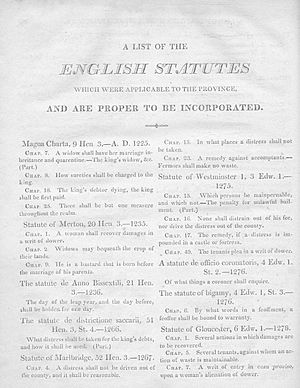Statute of Merton facts for kids

|
|
| Long title | Ancient Statute of Merton |
|---|---|
| Citation | 20 Hen 3 |
| Introduced by | Barons of the Peerage of England |
| Dates | |
| Royal assent | 1235 by Henry III of England |
| Other legislation | |
| Relates to | Magna Carta |
|
Status: Repealed
|
|
The Statute of Merton was an important law passed in England way back in 1235. It's also known as the Provisions of Merton. This law was created during the time of King Henry III.
Many people consider the Statute of Merton to be the very first English law, or "statute." It's even printed as the first one in a famous collection of laws called The Statutes of the Realm. This law had 11 different parts, or "chapters."
The king and the powerful nobles, called barons, agreed on these rules in a place called Merton. This was a time when the barons often tried to limit the king's power. It was similar to what happened with the Magna Carta about 20 years earlier.
Contents
What the Statute of Merton Did
This law covered several important things for people in England. It helped to clarify rules about land and family matters.
Rules for Land Owners
One big part of the statute was about land. It allowed a Lord of the Manor (a powerful landowner) to fence off, or "enclose," parts of common land. Common land was land that everyone in the village could use, often for grazing animals.
However, there was a rule: the lord had to leave enough open land for his tenants (people who rented land from him) to use for their animals. The law also explained how lords could claim rights over unused land, woods, and pastures. This helped to develop early ideas about who owned what in English law.
Impact on English Law
The Statute of Merton quickly became a key part of English common law. Common law is a system where laws are made by judges' decisions and traditions, not just by written rules. This statute helped make clearer rules about land ownership. It was even used in the law of the Lordship of Ireland.
Later on, in 1550, a powerful leader named John Dudley used this old law again. He allowed lords to enclose their land more freely. This was a bit unusual because at that time, many leaders were against too much land enclosure.
Family and Women's Rights
The statute also talked about family matters. For example, it stated that "He is a bastard that is born before the marriage of his parents." This meant that if parents had a child before they were married, that child was considered illegitimate.
The law also dealt with some rights for women. It mentioned "dowries," which were gifts or property a wife brought to her marriage. It said that "A woman shall recover damages in a writ of dower," meaning women could get back their dowry if something went wrong. It also gave widows the right to decide what happened to the crops on their land after their husbands died.
When was this Law Made?
The Statute of Merton was passed in 1235. It got its name from Merton, the place where it was agreed upon. It's special because many people see it as the first official English statute.
You might have heard of the Magna Carta, which was first created in 1215. Some people think of it as a statute even earlier than Merton. However, the official collection of laws, The Statutes of the Realm, doesn't list Magna Carta as a statute until a later confirmation in 1297. Another old document, the Charter of the Forest, was passed in 1217 but isn't usually called a statute.
See also


